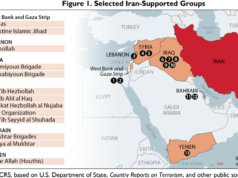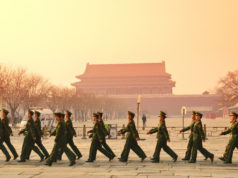China and India are the world’s fastest-growing major economies, the largest and third-largest by purchasing power. Together they account for one-third of humanity. Were they to form an alliance, they would dominate mainland Eurasia and the sea lanes of the Indian Ocean and Western Pacific that carry a preponderance of the world’s maritime energy trade. Yet these Asian civilization-states seem destined to compete in the 21st century – even as the United States and India are increasingly partners, if not allies, in shaping a balance of power that tilts in the direction of the democracies rather than being controlled by Beijing.
India fought a war with China in 1962 over their contested border, but the enduring competition between them since that time has always been about more than their largely uninhabited and resource-poor border regions. Indeed, the India-China rivalry is generated by some of the same dynamics as those fueling the growing strategic competition between Washington and Beijing. China’s military pressure on America’s forward-deployed posture in East Asia, its attempts to drive wedges between the United States and its allies, and its assertive attempts to whittle away at freedom of navigation and overflight in the East and South China seas are, for the United States, the mirror images of China’s military pressure on India’s northern border, its military and political penetration of India’s neighbors, and its naval activity all along India’s maritime periphery, from Gwadar in Pakistan to Hambantota in Sri Lanka to Chittagong in Bangladesh. In the same vein, India’s “Act East” policy of elevating strategic and economic engagement with Southeast and East Asia dovetails with the U.S. “rebalance” to Asia; both are pivoting to the region, as seen in their respective closer ties to Japan, Australia, Vietnam, Myanmar, and other states.
China’s Initial Rise
In 1998, India tested nuclear weapons, and then-Prime Minister Atal Bihari Vajpayee justified this new posture in secret correspondence to President Bill Clinton as a response to China’s military buildup and Beijing’s arming of India’s enemy Pakistan. In a striking turnaround, Vajpayee called India and the United States “natural allies” with shared interests in managing Chinese power and defeating terrorism, and who should cooperate more closely after decades of geopolitical alienation. This led to the forging of a U.S.-India strategic partnership in the 2000s centered on military cooperation and acceptance of India’s status as a nuclear-weapons state through U.S. support for normalizing civilian nuclear trade with India in the International Atomic Energy Agency and the Nuclear Suppliers Group. Under Prime Minister Narendra Modi, India is again reaching out to the United States to help balance against China, including by strengthening the Indian armed forces and promoting India’s economic development.
Unlike in 1962, when the balance of capabilities between them was quite even, China today has a military budget four times larger than India’s. China’s military is qualitatively superior, with advanced technological lead and focused investments in asymmetric and power-projection capabilities. China has pulled ahead decisively just over the past decade, making it more accurate to talk about the imbalance of power between them than any kind of stable balance of power. This is dangerous for India and destabilizing for the region. Prime Minister Modi has explicitly linked his agenda of economic revitalization—India this year surpassed China in economic growth rates—to the need to modernize India’s defense base, pointing out that a lackluster economy cannot provide a resource base adequate for India’s armed forces.
In economic terms, China’s nearly $10 trillion economy dwarfs India’s—although India is likely to close the gap over the coming few decades, as its favorable demographics and lower levels of development enable more rapid catch-up growth. In the near term, the magnitude of China’s economic and military lead reinforces the risk that China could become Asia’s dominant power and the imperative for India to pursue strategies of internal and external balancing to hedge against this danger. The current chairman of the prime minister’s National Security Advisory Board, former foreign secretary Shyam Saran, made the point explicitly:
Managing an essentially adversarial relationship with China will require a mix of expanded engagement and robust deterrence. There is greater power asymmetry between our two countries than ever before and this will require asymmetric responses…. Above all, we must reject the notion that we are condemned to live with the current asymmetry with China. If any country has the prospect of closing the gap with China, it is India and a strong and committed government will be able to pursue this goal. I believe it must.
India’s strategic objective, then, is righting the imbalance of power between it and China, not permanently accommodating itself to overweening Chinese strength.
Competition and Cooperation
In 2014, Modi took office after a campaign in which he cannily challenged Chinese territorial revisionism even as he promised to boost India-China business ties. During the campaign, he promised to resist China’s “mindset of expansion” and accused the previous Indian government of “making a mockery of itself with its limited and timid approach” to India’s primary strategic competitor. At the same time, he signaled his interest in securing high levels of Chinese trade and investment to help India grow. As one of his early moves in foreign policy, last September, Modi hosted President Xi Jinping for what was to be a friendly visit focused on turning a new page in relations by qualitatively upgrading the two countries’ economic relationship after years in which a combination of Indian protectionism and Indian security concerns constrained economic cooperation.
However, Modi was personally affronted when, on the eve of Xi’s arrival, China launched a military skirmish along the two countries’ contested border. Chinese troops were pushing into Indian-claimed territory even as he welcomed Xi with red-carpet treatment. Chinese diplomacy claims to be subtle, but Beijing seriously miscalculated. During their meeting, Xi did pledge $20 billion in new Chinese investments in India. Nonetheless, a summit meant to deepen economic cooperation was overshadowed by a military standoff and Modi learned that China was unlikely to be the kind of partner India could trust. Modi’s May 2015 visit to China sought to turn the page by focusing on closer economic cooperation, but candid disagreements between the two countries on security issues similarly colored this summit.
In contrast, Modi’s September 2014 Washington summit with President Obama produced an unusually detailed joint declaration that laid out a range of areas in which to deepen cooperation. This included the South China Sea, where they announced a joint interest in freedom of navigation and overflight, and against any use of force to change the status quo. Modi then offered to host Obama for India’s Republic Day parade—a first for a country whose traditional non-alignment led it to welcome leaders from Asia, Russia, and the developing world rather than the West at this annual ceremony. It was also highly unusual to schedule two summits with an American president only four months apart, but the two leaders obviously had much to discuss.
On January 25th, 2015, Modi met Obama on the Delhi airport tarmac with a bear hug that The New York Times called the signal of a new “Great Game” in Asia—between India and the United States on the one hand and China on the other. Once they got down to business, common anxiety about China, and a common interest in concerting to manage it, drove the conversation between the leaders of the world’s biggest democracies. Referring to a long list of issues shared by the two countries, Peter Baker wrote:
[W]hen [Obama] and Prime Minister Narendra Modi of India sat down to talk, the first 45 minutes were dominated by just one: China. Mr. Obama and his aides discovered to their surprise that Mr. Modi’s assessment of China’s rise and its impact on the greater strategic situation in East Asia was closely aligned with their own. Just as they did, Mr. Modi seemed increasingly uneasy about China’s efforts to extend its influence around the region and interested in a united approach to counter them.
Given this common concern, Modi and Obama discussed a variety of ways to strengthen defense and security cooperation. These include, in the bilateral channel, a new 10-year defense agreement to facilitate joint military education and training as well as enhanced U.S. defense sales to India (the world’s largest arms importer) and defense co-production premised on the sharing of sensitive but potent U.S. military technologies. In a Joint Strategic Vision document, Obama and Modi declared a partnership spanning the region “from Africa to East Asia,” agreed to move India closer to membership in APEC, and pledged a common interest in upholding freedom of navigation and overflight across the region, “especially in the South China Sea.”
No More Non-Alignment
Modi’s embrace of Obama marks the demise of India’s tradition of nonalignment, which may have suited the country when it was weak and poor. Rising and strong, India needs a new foreign policy, which Modi and his advisors appear to understand. Previous administrations constructed a strategic partnership with the United States almost by stealth; this backfired, for instance, in India’s failure to adopt a suitable liability law to implement the 2008 civilian nuclear agreement, which was designed as the centerpiece of the new relationship. In January 2015, with Obama by his side, Modi rejected this legacy, making clear that India had a compelling national interest in a more open alliance with the United States to overcome its security and development challenges.
From an American perspective, managing the Asian balance of power becomes much easier to the extent that there is a strong, friendly state of similar weight to China next door, which is why Washington must continue to support the Indian government’s efforts to fuel the kind of sustained economic growth India enjoyed in the 2000s, when it grew at annual rates approaching 10 percent. The United States also has a compelling interest in promoting India as a successful democracy, to demonstrate to other emerging powers that they need not mimic China’s authoritarian development model in order to modernize. A vibrant Indo-American partnership, in conjunction with healthy U.S. alliances in Europe and Japan, is likely to create a very different strategic future for Asia and the world than the Sino-centric one championed in Beijing but opposed by nearly every other power.
Daniel Twining is Senior Fellow for Asia at the German Marshall Fund of the United States. He served on the Secretary of State’s Policy Planning Staff during the George W. Bush administration and was previously the Foreign Policy Advisor to Senator John McCain.





